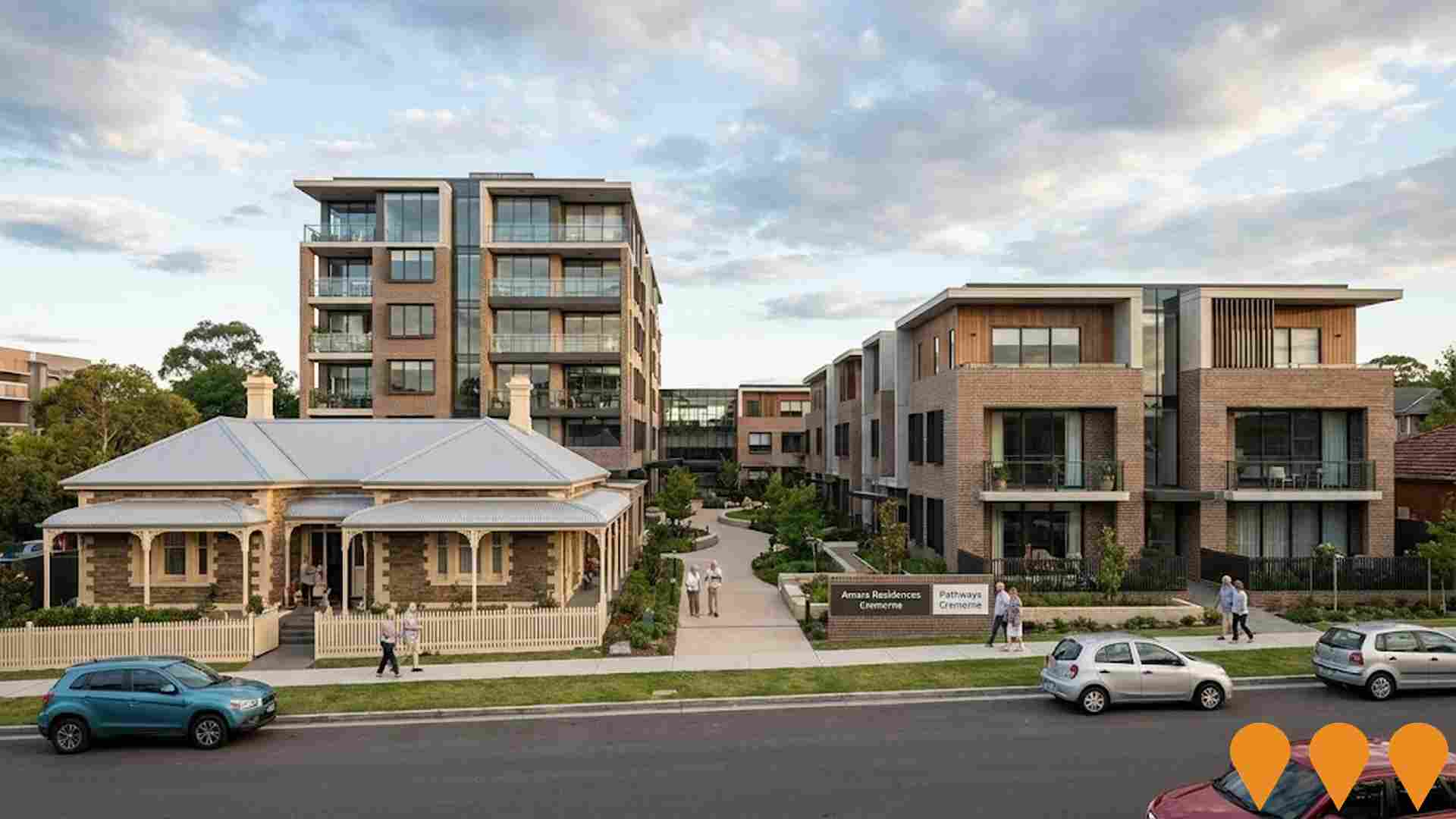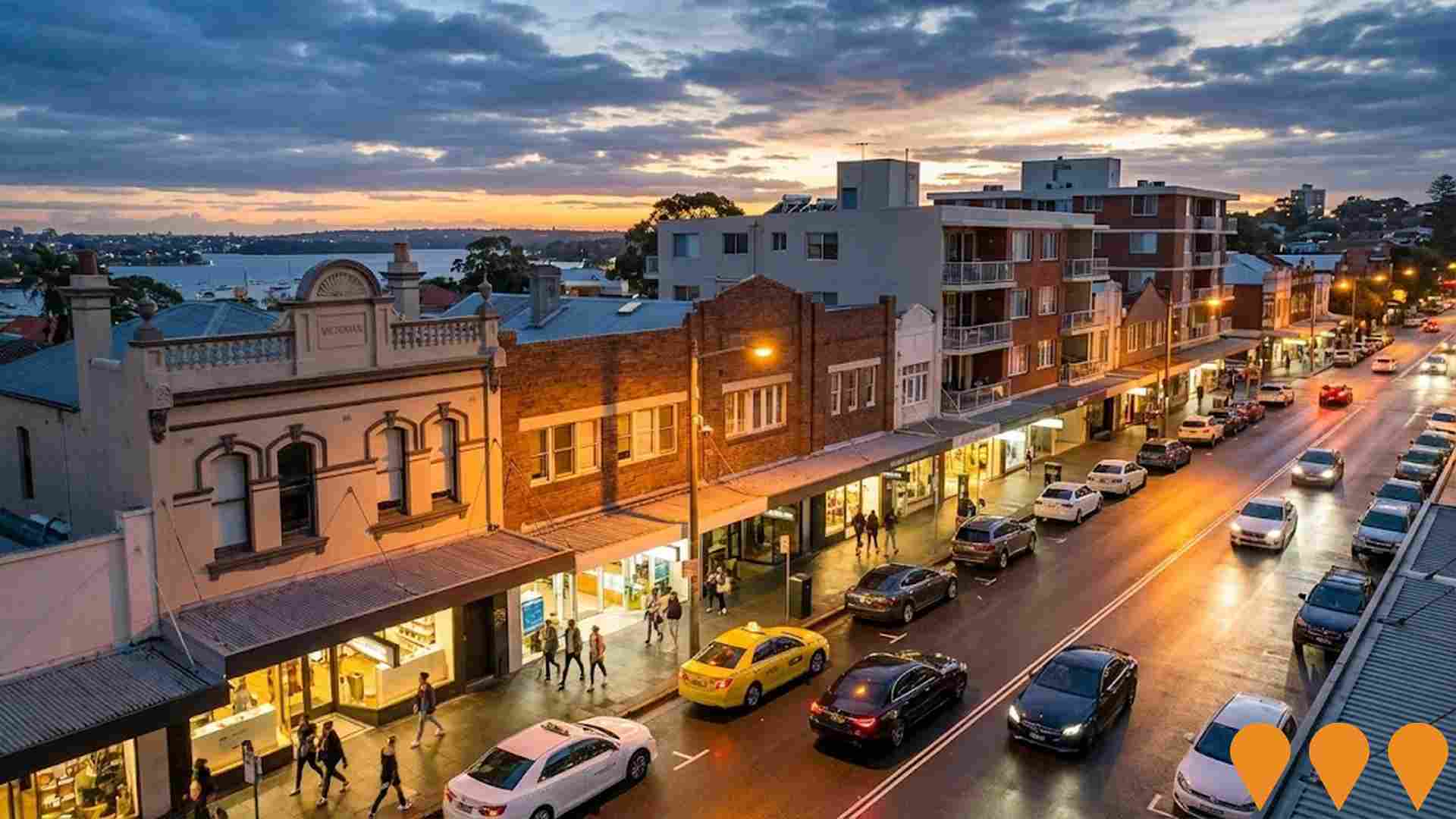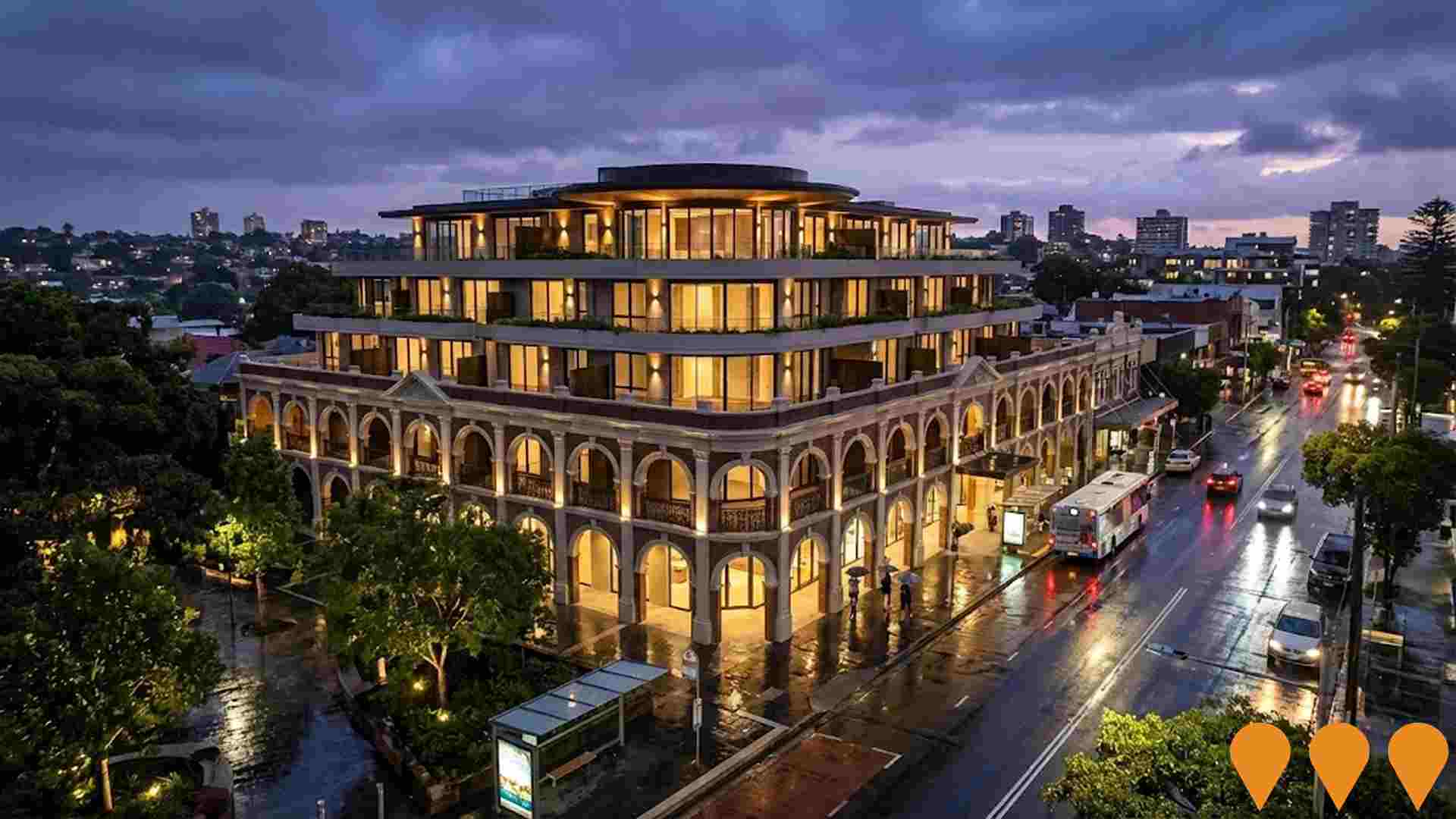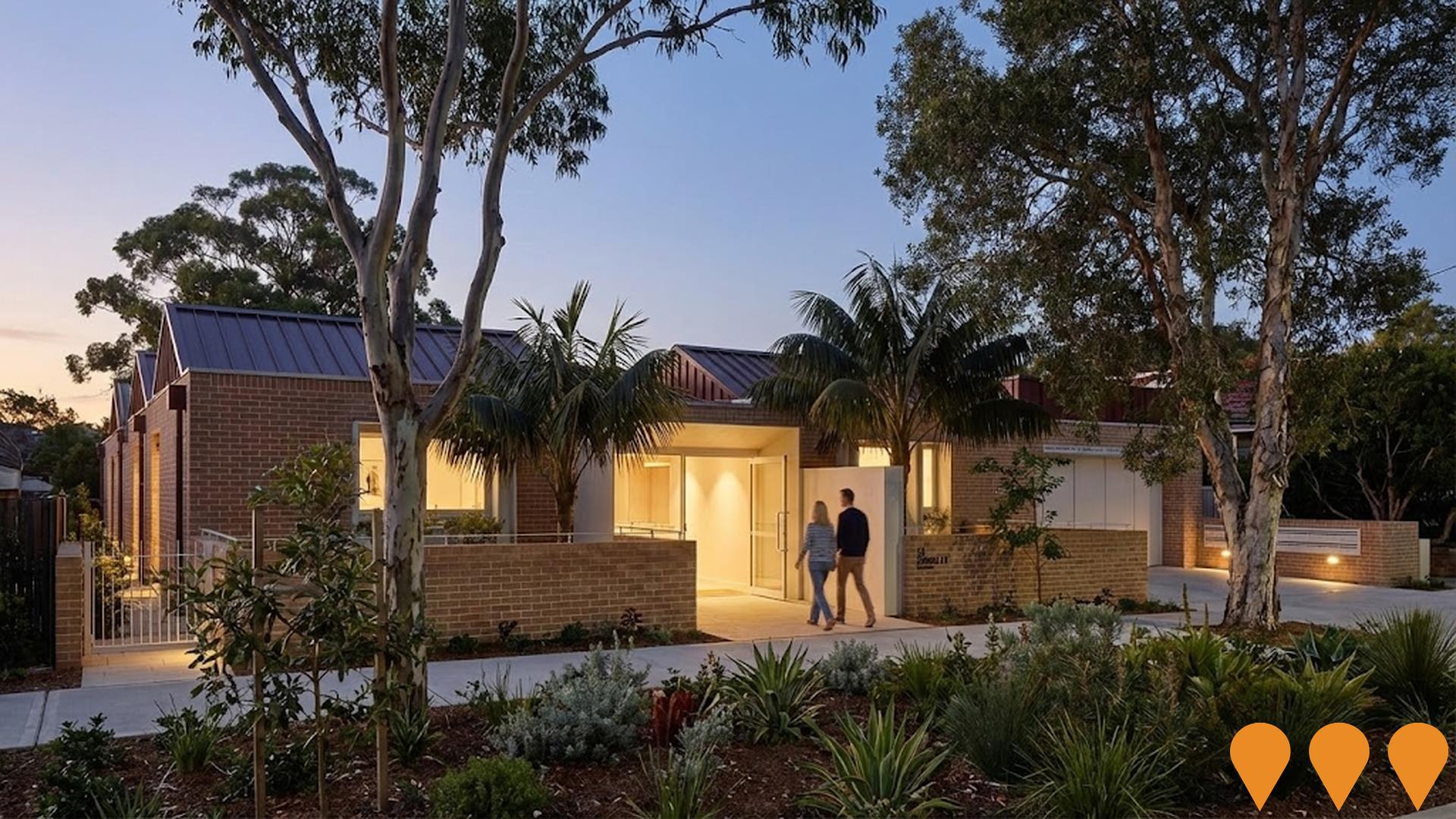Chart Color Schemes
est. as @ -- *
ABS ERP | -- people | --
2021 Census | -- people
Sales Activity
Curious about local property values? Filter the chart to assess the volume and appreciation (including resales) trends and regional comparisons, or scroll to the map below view this information at an individual property level.
Find a Recent Sale
Sales Detail
Population
Mosman - North is positioned among the lower quartile of areas assessed nationally for population growth based on AreaSearch's assessment of recent, and medium term trends
Mosman - North's population, as of August 2025, is approximately 14,378. This figure represents an increase of 615 people since the 2021 Census, which recorded a population of 13,763. The growth is inferred from the estimated resident population of 14,353 in June 2024 and an additional 34 validated new addresses post-census. This results in a population density ratio of 4,383 persons per square kilometer, placing Mosman - North within the top 10% nationally according to AreaSearch's assessment. The area's 4.5% growth since the census is close to the SA4 region's rate of 5.4%, indicating strong growth fundamentals. Overseas migration contributed approximately 91.5% of recent population gains in Mosman - North.
AreaSearch uses ABS/Geoscience Australia projections for each SA2 area, released in 2024 with a base year of 2022, and NSW State Government's SA2 level projections where applicable, released in 2022 with a base year of 2021. These projections indicate a decline in overall population by 47 persons by 2041. However, specific age cohorts are expected to grow, notably the 85 and over group, projected to increase by 686 people.
Frequently Asked Questions - Population
Development
Residential development activity is lower than average in Mosman - North according to AreaSearch's national comparison of local real estate markets
Mosman North averaged approximately 29 dwelling approvals annually over the past five financial years ending June 2021, totalling 149 homes. As of July 2026, 5 approvals have been recorded in FY-26. Despite population decline, housing supply has remained adequate relative to demand, resulting in a balanced market with diverse buyer choices. The average expected construction cost value for new dwellings was $2,298,000 during this period, indicating a focus on the premium market.
Commercial approvals totalled $1.4 million in the current financial year. Compared to Greater Sydney, Mosman North's construction activity per capita is comparable, supporting regional market stability. However, it remains below the national average, suggesting possible planning constraints. Recent development comprises 33.0% detached dwellings and 67.0% medium and high-density housing, promoting affordability for entry-level buyers, investors, and downsizers. With approximately 374 people per dwelling approval, Mosman North reflects a mature market with stable or declining population forecasts, potentially easing housing pressure and favouring buyers in the future.
Given stable or declining population forecasts, Mosman - North may experience less housing pressure, creating favourable conditions for buyers.
Frequently Asked Questions - Development
Infrastructure
Mosman - North has very high levels of nearby infrastructure activity, ranking in the top 20% nationally
Changes to local infrastructure significantly affect an area's performance. AreaSearch has identified 28 projects likely to impact the area. Notable projects include Kleo Mosman, Saint Martens, 93-101A Awaba Street Residential Development, and Redan Lane. The following list details those most relevant.
Professional plan users can use the search below to filter and access additional projects.
INFRASTRUCTURE SEARCH
 Denotes AI-based impression for illustrative purposes only, not to be taken as definitive under any circumstances. Please follow links and conduct other investigations from the project's source for actual imagery. Developers and project owners wishing us to use original imagery please Contact Us and we will do so.
Denotes AI-based impression for illustrative purposes only, not to be taken as definitive under any circumstances. Please follow links and conduct other investigations from the project's source for actual imagery. Developers and project owners wishing us to use original imagery please Contact Us and we will do so.
Frequently Asked Questions - Infrastructure
Amara Cremorne by Pathways
An integrated seniors living development featuring 58 luxury independent living units under the Amara Residences Cremorne brand and a 41-bed residential aged care facility operated as Pathways Cremorne. The development comprises 3 four-storey buildings and 1 seven-storey building, with adaptive reuse of 6 heritage-listed cottages on Parraween Street. The project includes supporting ancillary uses, allied health services, and a publicly accessible through-site link. Approved by the NSW Independent Planning Commission in April 2025 following a multi-year planning and consultation process.

Military Road Mega Lot Apartment Development
State Significant Development comprising amalgamation of Honeysuckle Garden nursery and Midas Tyre Auto Service sites into a 3,207sqm mega lot for 107 new apartments up to eight storeys with 3% affordable housing. Declared SSD by NSW Planning Minister on June 12, 2025, bypassing local council approval and being fast-tracked through Housing Delivery Authority assessment within 275 days.

Huntington Residences Cremorne
A luxury $42 million apartment development by WINIM featuring 13 one, two and three-bedroom apartments. The development combines restoration of the 1937 Clifford Finch building with contemporary architecture, inspired by Cremorne's natural beauty and Robertsons Point Lighthouse.

Park Residences Cremorne
A boutique development by Abadeen featuring 2 and 3 bedroom apartments with panoramic Middle Harbour views. Designed by MHNDU Architects with premium finishes including V-Zug appliances, natural stone benchtops, and communal wine cellar.

The Alexander Luxury Living
$30 million luxury seniors housing development on the historic Ellamatta mansion site in Mosman, featuring refurbishment of the existing mansion for common areas and seniors living spaces, along with 23 independent living units on a 7648 sqm site adjacent to the existing Glengarry aged care facility.

Eleve Cremorne
A boutique development of 22 oversized apartments by HELM featuring 1, 2 and 3 bedroom units. Designed with marble finishes, Miele appliances, European oak timber flooring, and Cavalier Bremworth wool carpet, within walking distance of Cremorne Village.

284B Military Road Mixed Use Development
Mixed-use residential and commercial development along the Military Road corridor, contributing to urban renewal and increased housing diversity in the Cremorne precinct.

93-101A Awaba Street Residential Development
Demolition of six existing homes and construction of a six-storey residential flat building comprising 29 luxury apartments (8 two-bedroom and 21 three-bedroom units) with two-level basement parking for 58 cars and lot consolidation under the Low and Mid-Rise Housing Policy. The development features Middle Harbour views, landscaped courtyards, deep soil planting, and EV charging points.

Employment
While Mosman - North retains a healthy unemployment rate of 3.5%, recent employment declines have impacted its national performance ranking
Mosman - North has a highly educated workforce, with the technology sector prominent. Its unemployment rate is 3.5%.
As of June 2025, 7,735 residents are employed, with an unemployment rate of 3.5%, which is 0.7% below Greater Sydney's rate of 4.2%. Workforce participation in Mosman - North is at the same level as Greater Sydney's 60.0%. The dominant employment sectors include professional & technical, finance & insurance, and health care & social assistance. Professional & technical jobs are particularly concentrated, with levels at 1.9 times the regional average.
However, construction is under-represented, with only 4.4% of Mosman - North's workforce compared to Greater Sydney's 8.6%. Labour force levels decreased by 0.2% over the year to June 2025 in Mosman - North, while employment declined by 1.1%, causing unemployment to rise by 0.8 percentage points. In contrast, Greater Sydney experienced employment growth of 2.6% and labour force growth of 2.9%. National employment forecasts from Jobs and Skills Australia, issued in May 2025, project a 6.6% increase over five years and 13.7% over ten years. Applying these projections to Mosman - North's employment mix suggests local growth of approximately 7.6% over five years and 14.9% over ten years.
Frequently Asked Questions - Employment
Income
The economic profile demonstrates exceptional strength, placing the area among the top 10% nationally based on comprehensive AreaSearch income analysis
Mosman - North has a median taxpayer income of $79,160 and an average of $208,667 according to the latest postcode level ATO data aggregated by AreaSearch for financial year 2022. This is exceptionally high nationally, contrasting with Greater Sydney's median income of $56,994 and average income of $80,856. Based on Wage Price Index growth of 12.61% since financial year 2022, current estimates would be approximately $89,142 (median) and $234,980 (average) as of September 2025. Census data reveals household, family and personal incomes all rank highly in Mosman - North, between the 95th and 97th percentiles nationally. The earnings profile shows that 38.0% of locals (5,463 people) are in the $4000+ category, contrasting with the metropolitan region where the $1,500 - 2,999 bracket leads at 30.9%. The district demonstrates considerable affluence with 48.3% earning over $3,000 per week. Housing accounts for 14.3% of income while strong earnings rank residents within the 95th percentile for disposable income and the area's SEIFA income ranking places it in the 10th decile.
Frequently Asked Questions - Income
Housing
Mosman - North features a more urban dwelling mix with significant apartment living, with above-average rates of outright home ownership
In Mosman - North, as per the latest Census, 32.6% of dwellings were houses while 67.5% were other types such as semi-detached, apartments, and 'other' dwellings. This contrasts with Sydney metro's figures of 17.9% houses and 82.1% other dwellings. Home ownership in Mosman - North stood at 41.9%, with mortgaged dwellings at 25.8% and rented ones at 32.3%. The median monthly mortgage repayment was $3,500, higher than Sydney metro's average of $3,085. The median weekly rent in Mosman - North was $600, compared to Sydney metro's $582. Nationally, Mosman - North's mortgage repayments were significantly higher at $1,863 and rents were substantially above the national figure of $375.
Frequently Asked Questions - Housing
Household Composition
Mosman - North features high concentrations of lone person households, with a higher-than-average median household size
Family households constitute 65.5% of all households, including 27.9% couples with children, 29.6% couples without children, and 7.1% single parent families. Non-family households account for the remaining 34.5%, with lone person households at 32.2% and group households comprising 2.3% of the total. The median household size is 2.3 people, larger than the Greater Sydney average of 2.1.
Frequently Asked Questions - Households
Local Schools & Education
Mosman - North demonstrates exceptional educational outcomes, ranking among the top 5% of areas nationally based on AreaSearch's comprehensive analysis of qualification and performance metrics
Mosman - North's educational attainment significantly exceeds broader benchmarks. 58.0% of residents aged 15+ hold university qualifications, compared to 30.4% nationally and 32.2% in NSW. Bachelor degrees are the most common at 37.5%, followed by postgraduate qualifications (16.7%) and graduate diplomas (3.8%). Vocational pathways account for 19.2% of qualifications, with advanced diplomas at 11.2% and certificates at 8.0%.
Educational participation is high, with 27.2% of residents currently enrolled in formal education. This includes 8.3% in primary, 7.8% in secondary, and 6.4% in tertiary education. The area's 4 schools have a combined enrolment of 1,541 students. Mosman - North demonstrates exceptional educational performance with an ICSEA score of 1166, placing its schools among the most advantaged nationally. The educational mix includes 2 primary and 2 K-12 schools. School places per 100 residents are 10.7, below the regional average of 19.2, with some students likely attending schools in adjacent areas. Note: where schools show 'n/a' for enrolments, please refer to the parent campus.
Frequently Asked Questions - Education
Schools Detail
Nearby Services & Amenities
Transport
Transport servicing is high compared to other areas nationally based on assessment of service frequency, route connectivity and accessibility
Mosman - North has 96 active public transport stops, all of which are bus stops. These stops are served by 72 different routes, together facilitating 9,550 weekly passenger trips. The area's transport accessibility is rated as excellent, with residents on average being located just 105 meters from the nearest stop.
On a daily basis, there are an average of 1,364 trips across all routes, which translates to approximately 99 weekly trips per individual stop.
Frequently Asked Questions - Transport
Transport Stops Detail
Health
Mosman - North's residents boast exceedingly positive health performance metrics with very low prevalence of common health conditions across all age groups
Health outcomes data shows excellent results in Mosman - North with a very low prevalence of common health conditions across all age groups. The rate of private health cover is exceptionally high at approximately 94% of the total population (13,500 people), compared to 86.4% across Greater Sydney and 55.3% nationally. The most common medical conditions in the area are arthritis and asthma, impacting 7.0 and 6.2% of residents respectively, while 74.1% of residents declare themselves completely clear of medical ailments compared to 75.2% across Greater Sydney.
As of 2021, 24.5% of residents are aged 65 and over (3,524 people), which is higher than the 20.1% in Greater Sydney. Health outcomes among seniors in Mosman - North are particularly strong, performing even better than the general population in health metrics.
Frequently Asked Questions - Health
Cultural Diversity
Mosman - North was found to be more culturally diverse than the vast majority of local markets in Australia, upon assessment of a range of language and cultural background related metrics
Mosman-North has a higher cultural diversity than most local areas, with 19.7% of residents speaking a language other than English at home and 38.2% born overseas. Christianity is the predominant religion in Mosman-North, accounting for 51.9% of its population. Notably, Judaism is equally represented in Mosman-North (1.0%) as it is in Greater Sydney (1.0%).
The top three ancestry groups are English (28.3%), Australian (18.7%), and Other (9.9%). Some ethnic groups show notable differences: French (1.1% vs 1.1% regionally), Russian (0.7% vs 0.7%), and Welsh (0.8% vs 0.7%) are similarly represented in Mosman-North compared to the regional averages.
Frequently Asked Questions - Diversity
Age
Mosman - North hosts an older demographic, ranking in the top quartile nationwide
The median age in Mosman - North is 45 years, which is significantly higher than Greater Sydney's average of 37 years and Australia's average of 38 years. Compared to Greater Sydney, Mosman - North has a higher percentage of residents aged 75-84 (9.6%) but fewer residents aged 25-34 (10.5%). According to the 2021 Census, the population aged 15-24 grew from 9.7% to 11.3%, while the population aged 45-54 decreased from 14.2% to 12.8% and the population aged 65-74 dropped from 11.5% to 10.4%. By 2041, demographic projections indicate significant shifts in Mosman - North's age structure. The population aged 85+ is expected to grow by 103%, reaching 1,323 people from 651. Notably, the combined population aged 65+ will account for 95% of total population growth, reflecting the area's aging demographic profile. In contrast, both age groups 15-24 and 0-4 are projected to have reduced numbers.



